“I believe that 15 years from now we’ll be standing here and we’ll be talking GEM. We won’t be talking Hass. People will go, ‘What is Hass?’” said Mary Lu Arpaia to a room of California avocado growers in 2017. Arpaia knows avocado varieties. She has been the director of the University of California’s avocado breeding program for a quarter century.
What is propitious about GEM? And more to the point for this post, is a GEM avocado tree as suitable for our yards as it might be for a commercial farm?
To answer this, we’ll look at GEM’s fruit characteristics, harvest season, the tree’s shape, bearing habit, and its tolerances and vulnerabilities. I’ll also survey the variety’s development, which occurred within the University of California’s breeding program.
Fruit characteristics
Fruit first. GEM is pretty, especially when immature or unripe. Here is an unripe and immature GEM avocado on a tree in October.

As the fruit matures, the peel gains a black background but the bumps — lenticels — remain yellow-green for some time. The fruit looks like a starry night, similar to the old Nimlioh variety from Guatemala. I find GEM’s speckled appearance attractive.
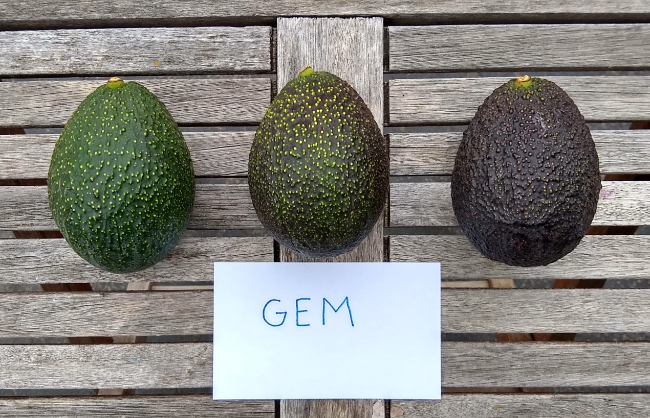
GEM avocados average in size slightly larger than Hass, and their shape is less pyriform and more like a fat egg.
Once cut open, you find a seed that is slightly larger than the seed of Hass and pointier too. And there often remains a fuzz of pulp coating the seed on GEM.
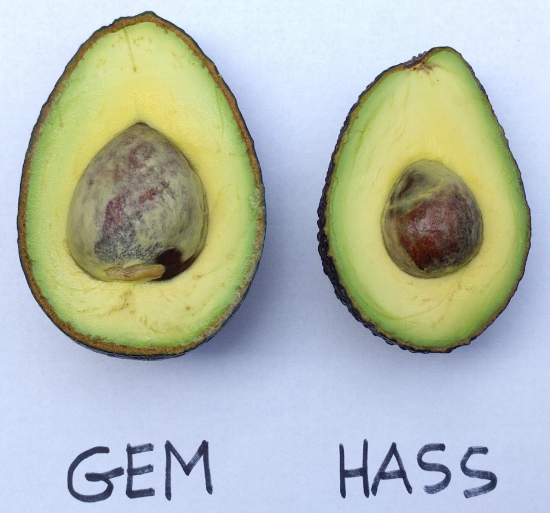
Compared to Hass, the skin of GEM is smoother, thicker, and grittier. It is also sometimes a touch more fragile and less pliable, which means that it doesn’t peel quite as well as Hass although I would still characterize GEM as a good peeler.
The taste of GEM? Excellent, top notch in every way. And to me, nearly indistinguishable from Hass. I doubt that I could pick out which is which in a blind taste test. The texture of GEM is sometimes slightly denser, and the flesh cracks a bit (like its mother, Gwen). And the color of GEM’s flesh is sometimes slightly paler. Otherwise, I can rarely detect anything peculiar in the flavor of GEM compared to Hass.
My four-minute video profile of the GEM avocado fruit:
Harvest season
GEM in Southern California is not harvested until March at the earliest but beginning in April more commonly, which puts it a month or two later than the beginning of the Hass harvest. GEM usually tastes best to me in May. And it remains good on the tree into July or maybe August here in San Diego County, probably later if you’re near the beach, certainly later if you’re north of Los Angeles.
Of course, when you harvest any variety also depends partly on how oily you prefer your avocados. GEM avocados don’t start dropping from a tree as soon as they’re mature so you can let them hang and accumulate high oil levels if that’s the taste you like.
Bearing habits
GEM is a good producer in a number of ways. One way is its consistency. All avocado varieties fluctuate in their fruit production from year to year, but GEM’s yearly yield doesn’t fluctuate as much as many other varieties. I have observed this on individual GEM trees, and more importantly, this has also been reported in scientific trials (see one from Irvine at 1:28 in this video).
This can be a preferred behavior if you’ve got a single tree in your yard. You’re more likely to get avocados from your tree every year.

While this is not the same as saying you’re going to get a lot of avocados from a GEM tree every year, GEM does also happen to be a very productive variety overall. In the same trial in Irvine mentioned above, GEM yielded more fruit in terms of weight compared to Hass and Lamb. Similar results have also been reported in a comparison between GEM and Hass in Ventura County by Brokaw Nursery.
Yet in a more recent and on-going trial in Ventura County comparing GEM to four other varieties, GEM’s yields are not the highest. Hass, Lamb, and Reed are higher on a per-tree basis. However, it’s important to note that the GEM trees were smaller than all other varieties except Reed. And on a yield-per-canopy-volume basis, GEM is the most efficient producer. (See 1:30 in this video.) (And see an update on this trial here.)
Put another way, GEM avocado trees produce a lot of fruit on a little tree. Like GEM’s behavior of producing avocados more consistently, this attribute of efficiency can also be of benefit to a backyard grower since most of us have limited square footage in our yards.
A GEM avocado tree also wants to produce fruit right out of the gate, right at planting. In fact, GEM is dangerously precocious. A GEM tree that is only knee high can make hundreds of flowers, but an avocado tree that is knee high isn’t ready to carry even a single fruit to maturity without risking stunted growth or even collapse.

In order to encourage healthy growth of newly planted GEM trees some farmers actively remove flowers while others wait and remove any fruitlets that have set, perhaps around June. I’ve tried it both ways and haven’t noticed a clear difference in the trees’ responses.
It seems that the new GEM tree is reacting to a stimulus that occurred before the flowering time, and the reaction can’t be stopped. One stimulus that clearly makes new GEM trees bloom like crazy is a winter of heavy rain, as seen in the winters of 2022-23 and 2023-24.
Some growers recommend avoiding this problem by topworking GEM onto established rootstocks. Or in a new planting, the rootstocks can be planted and allowed to establish for a year or two before grafting to GEM. I’ve seen both methods work successfully.
Variety development and history
Let’s not be surprised that GEM is precocious, considering its lineage. As the GEM patent reads, “The seed that produced the new variety of the present invention was collected in 1985 from open-pollinated avocado trees of the ‘Gwen’ variety.” Gwen is likewise precocious.
Furthermore, Gwen is thought by many to be a great grandchild of the Lyon variety — Gwen is a seedling of Thille, Thille is a seedling of Hass, Hass is probably a seedling of Lyon. Wrote Bob Bergh in “Breeding Avocados at C.R.C.” of the Lyon variety: Lyon “bears so precociously and so heavily that the tree is severely stunted and sometimes killed outright.”
Bergh was in charge of the University of California’s avocado breeding program during the 1980s when the seed that ultimately produced the original GEM tree was planted. He was also in charge during the 1960s when the seed that produced the original Gwen tree was planted.
In the 1960s, the variety Fuerte was seen by many as the best eating avocado. Fuerte’s flaw was that its tree didn’t produce consistently enough. The Hass variety had come along and proven to be a tree of more consistent production, except that the Hass fruit had the flaw of blackening skin. At the time, black skin on an avocado was associated with damage to the fruit. So in the 1960s, Bergh was trying to breed an avocado variety that combined Hass and Fuerte, that had a tree that produced at least as well as Hass but whose fruit stayed green like Fuerte. Bergh’s answer was Gwen. Gwen is like a green-skinned Hass.
But breeding avocados doesn’t happen overnight, and by the time Gwen reached avocado farmers in the late 1980s, avocado eaters had begun accepting the black skin of Hass. In fact, avocado eaters in California had started demanding that their avocados ripen black. It’s almost like Gwen was conspired against.
In the mid 1980s, around the same time that Gwen was going from patent into commercial production testing, Bergh was continuing to plant seeds to discover new varieties, and some of those seeds had come from Gwen avocados. One such Gwen seed was planted in field 3, row 29, spot 5 on a ranch in Camarillo, Ventura County.
This 3-29-5 seedling tree ended up producing fruit that ripened black like Hass (check one!), and the tree produced a lot of fruit (check two!). More than that, the tree produced all that fruit on a compact canopy like its mother Gwen (check three!). It was like a black-skinned Gwen.
It was an assistant to Bergh who most often observed and collected data on this seedling tree and the others on the Camarillo ranch, and ultimately tree 3-29-5 would bear his name, via his initials: Gray Edward Martin.
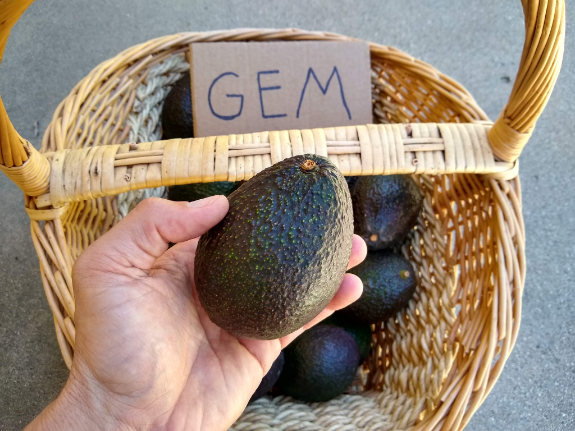
Tree shape and size
GEM’s tree architecture offers mostly advantages. Consider some of the oldest GEM trees, grafted in the 1990’s at a ranch in Saticoy in Ventura County, where the trees are spaced 20 feet apart. Today, nearly 30 years later, these GEM trees barely need any pruning.
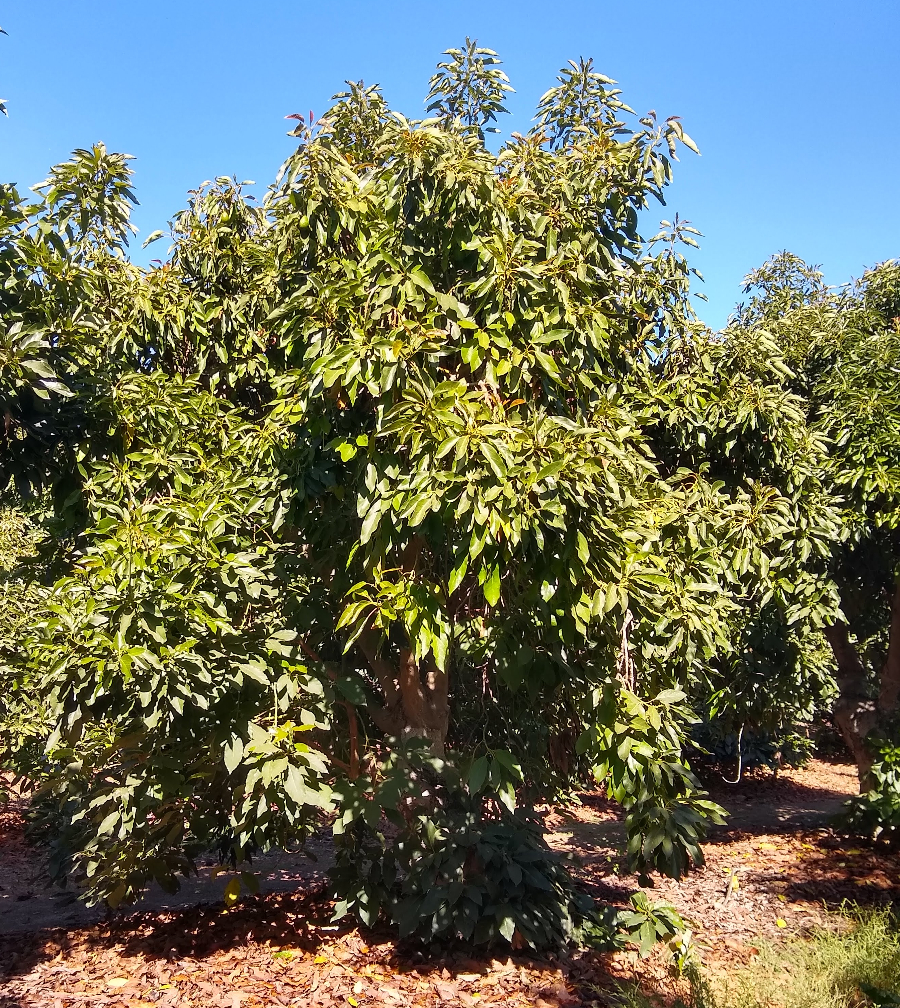
That illustrates the speed of growth and tree shape of GEM: relatively slow and compact.
On another part of this same ranch, Hass trees were planted 10 feet apart in 2004, but the required thrice yearly pruning and reduction of overall yields after year eight lead the ranch manager to topwork the trees to GEM in 2019.
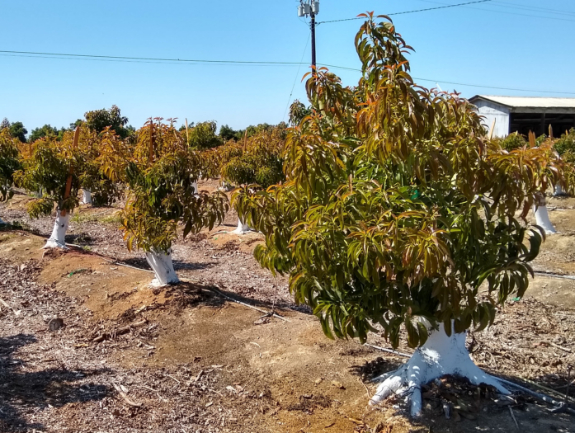
This grower’s experience is that GEM avocado trees are manageable long term at a spacing of as little as 10 feet between trees because of their shape and relatively slower growing speed while Hass need more like 12 or even 15 feet between trees, minimum.
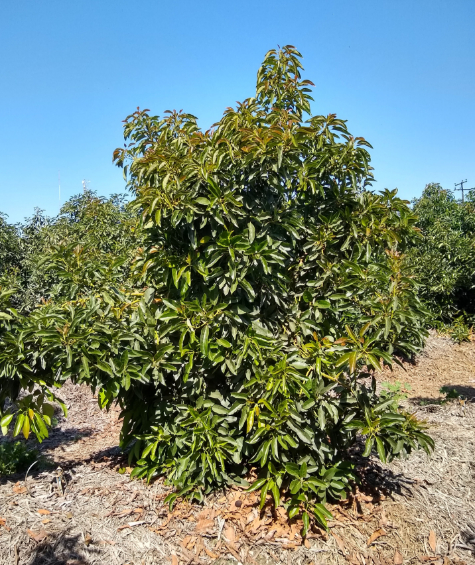
I have seen farmers plant GEM trees as close as six feet apart down the rows, but I haven’t seen such close spacing maintained for many years so I’m unsure how sustainable it is.
Regardless, the take away is that GEM trees are less vigorous than Hass and most other varieties.
Tolerances and vulnerabilities
This can be of some disadvantage to home growers, however. GEM being less vigorous means it isn’t as fast to outgrow challenges. In my own yard, I’ve had slightly more trouble getting GEM trees through their first few years compared to some other varieties. They haven’t coped well with gopher attacks, root competition from larger nearby trees, and damage from heat or cold. GEM has seemed to me to not be as generally tough a variety as some others when encountering these challenges that occur in many home garden situations.
So, GEM’s slower rate of growth is mostly an advantage, as is GEM’s style of carrying its fruit. GEM often sets fruit in clusters and holds those avocados inside its canopy, hidden under foliage. The fruit is thus shaded and unlikely to sunburn.
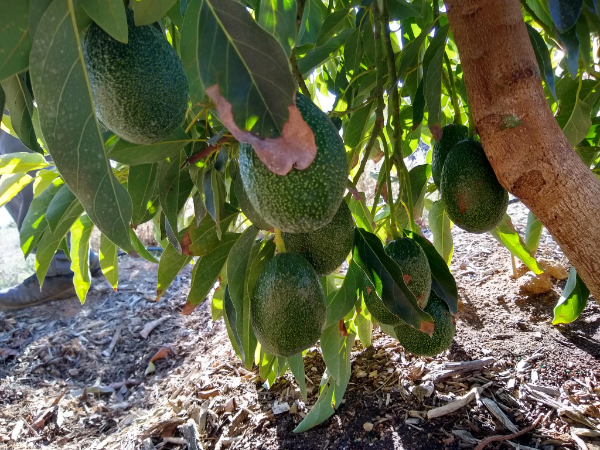
But this comes with the vulnerability of more skin scarring. You notice it a bit in the above photo.
Below is a random group of GEM avocados next to a group of Hass picked from trees in the same grove in Fallbrook. You can see that a few more of the GEMs have skin blemishes.
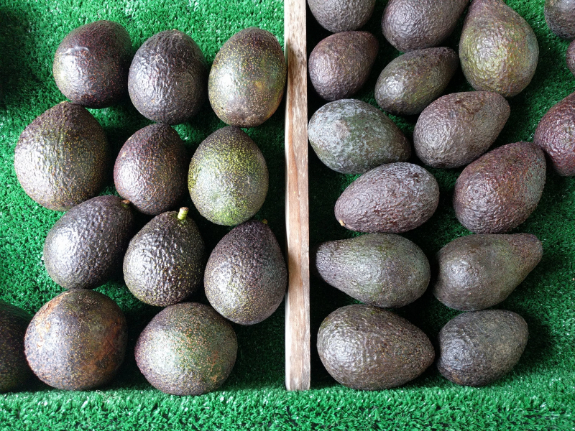
The scarring is mostly caused by fruit rubbing against nearby stems, branches, leaves, and other fruit in a cluster. Farmers are trying to figure out how to minimize this because such superficial blemishes affect how much they get paid for their avocados. (See a discussion on GEM scarring here.)
Personally, I couldn’t care less about this issue though, as I’m a home grower and I’ve never seen this minor scarring affect the underlying flesh.
While there haven’t been proper studies done on the heat and cold tolerance of GEM compared to other varieties, there have been anecdotes reported from growers in various parts of California and in other parts of the world. Some have noticed slightly more cold tolerance in GEM compared to Hass in specific ways. For example, Mary Lu Arpaia has said that the GEM trees in a planting in the San Joaquin Valley had a better spring bloom compared to nearby Hass trees after a freeze in 2007.
And for heat tolerance? A commercial farmer with decades of experience growing GEM in San Diego County told me he noticed GEM trees to be damaged a bit less than nearby Hass during the extreme heat of early September, 2020. On the other hand, I heard another farmer in the same area say that he didn’t notice any higher heat tolerance in GEM compared to Hass in his grove during the same event.
Maybe we should conclude that the jury is still out on GEM’s precise level of cold and heat tolerance. My own GEM trees have shown mixed responses to extremes in temperature.
Is GEM a good fit for your yard?
GEM is not perfect but it is an all-around excellent avocado tree. Its main comparative advantage is its size and shape, and therefore its efficiency, in avocado yield: GEM produces a lot of fruit while taking up little yard space. So if you’ve only got a 10-foot by 10-foot corner of the yard for an avocado tree, GEM fits your needs very well.
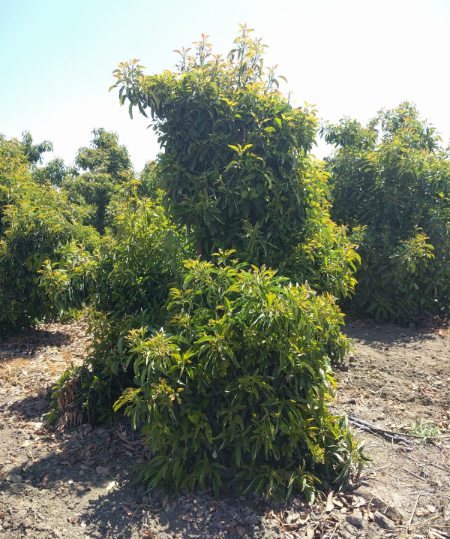
Will farmers be moving from a focus on Hass to a focus on GEM in the next 15 years? I don’t know. But I’m willing to make a different prediction: Home growers like us with an appreciation for avocado diversity and the desire for year-round fruit from our own yards are going to indirectly spur California farmers to include varieties even beyond GEM in their future plantings. No more single-variety output, Hass or GEM or otherwise.
This will be a win for everyone.
Here is a video profile of the GEM avocado tree:
Where to buy a GEM avocado tree? See this post.
All of my Yard Posts are listed HERE
I’m able to write profiles of avocado varieties like this one and keep The Yard Posts ad-free because of your direct support. Thank you! Learn how to become a Supporter HERE

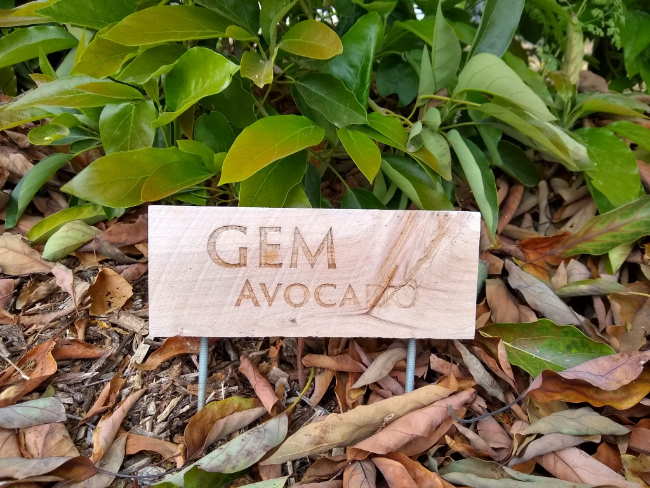


Just learned about GEM variety. Very interesting! I for one love Reed more than Hass but it’s great to have so many options in the avocado universe.
Thank you Greg! I got a GEM about 5 years ago from Bonita Creek Nursery. They actually have a very good selection of avocados and are worth checking out for fruit tree lovers in general. I live about two blocks from the ocean, but keep my avocado trees sequestered in my backyard. GEM is growing about 6 feet between Reed and Pinkerton, so it’s almost a solid wall of avocados. I’m having to do some pruning every year to keep these guys small enough to fit and short enough to pick without a ladder, but I like having the variety. As you spoke about “sustainability” of such close plantings, we’ll have to see how it goes!
For the first few years, I had to remove an incredible amount of pea-sized avocados (very precocious!) since the tree wasn’t ready yet. Its production is just getting going this year, and I’m going to make some GEM guacamole tonight! Yay! For the longest time I couldn’t find out much about GEM’s, so I’m thrilled to get your posts, and I use your website often for the answers I seek. Thank you!!! Linnea L
Hello Linnea, your post is from 2021 and was wondering how tall are your Gems. I’m planting mine at 6′ centers by 9′ tall. Hope to get a couple hundred with ad tree that tall. I have read that growers are getting 3′-6′ a year of growth. That’s a lot of growth!
Good luck with your trees.
Joe
Is it common or the usual of GEM having fiber strings?
Hi Che,
GEMs don’t usually have any strings, or only a tiny bit near the stem.
Great info on the GEM..you know more about this than Gray..LOL
Excellent article. My grafted baby Gwen is next to my baby GEM, I thought Gwen’s are wimpy growers, but it is throwing out better growth than the GEM. Speaking of gophers, this season so far on our 1/3 acre I’ve trapped/killed 22. All due to your article on the Cinch trap, they are great.Thx for all the info.
Thanks, Frank. That’s a lot of gophers. I’m catching many with my Cinch traps this season too. It seems more than usual, and all of the catches lately have been small gophers, which I figure are young ones.
Hi Greg,
I am wondering if I could have permission to publish a few of your GEM avocado photos in our magazine, giving you photo credit.
Cheers,
Nancy Power
Hi Greg,
I’ve got two younger GEM’s in the ground since May last year. They are healthy, vigorous and growing nicely. One of them has held three avocado’s since transplant that are about ready for picking. But neither of them flowered at all this Spring. Are they normally late to bloom, or is it possible that my microclimate didn’t induce the GEM’s to flower? I’m in the Gird Valley of Fallbrook, and some say low in the valley isn’t ideal but my neighbors have plenty of fruit on their mature Hass trees. Also, by contrast, my 7/8 year old Fuerte and Reed both flowered a bit set some fruit, and the Lamb and Pinkerton (transplanted the same time as the GEM’s) are flush with tons of flowers and some fruit. All the trees are in the same area of my grove.
Given the GEM’s productive nature even at a young age, I’m curious why mine didn’t give me any flowers this year… or maybe I just need to be patient?
/Dave
I should have added, the Gems are 6-7 feet tall, not baby’s, they were transplanted from 15 gal pots, 5-6 feet at the time and have added at least a foot and plenty of shoots and leave growth.
Hi Dave,
I doubt your area is the problem. For the tree holding fruit, we might suspect that it flowered well last year and is alternating with an off year this year. Even though GEM is said not to alternate as much as some other varieties, it certainly does still alternate to a degree, as I’ve seen in my own yard.
For the other tree, that’s a bit stranger. All I can say is that I’ve currently got three new GEMs in the ground right now, and this spring they have all flowered differently. One flowered extremely, one flowered moderately, and one only had a single inflorescence. They are on different rootstocks so that might play a part.
If your GEMs don’t flower next spring after having a healthy year of leaf growth this summer, then I’d start to worry. But maybe as of now we can explain it with a combination of youth, rootstock, alternation, and who knows what else (heat wave last Labor Day do a little unseen damage, for example?).
Greg! Stop teasing us with these posts recommending Gem avocado’s…you get me all excited and want to plant but where can I buy them?? I keep calling nursery’s with no luck. Lamb, Hass, some Bacon….no Gem. These plants are the new unicorn. I’m in Ventura County. If anyone know’s a nursery near by please let me know. I want to buy 4. Great site Greg.
Sorry, Eric! It’s so irritating. I know. I’ve even kept GEM off my top recommendations for a variety to grow in a small yard space because there’s no point if no one can buy the tree.
As far as I know today, you have to either make an order for 20 or more trees from Brokaw in Ventura (and wait at least two years for them to be ready), or you must make a trip down south. Here in San Diego County there are two nurseries that will sell GEM trees in small quantities to home growers like us: Subtropica and Maddock. I can’t guarantee that they have anything in stock at a given moment because all avocado trees — and especially GEM — are in high demand right now, plus a heat wave last Labor Day damaged a lot of stock, but they are our best bet.
Subtropica: https://www.subtropicanurseries.com/
Maddock: http://www.maddockranchnursery.com/
Great post Greg. I have three GEM trees and I would agree they are slow growing trees when compared to my other varieties. I have also noticed that they do not tolerate heat very well.
I picked up a 15gal GEM at Maddock this last Saturday May 29th and they had about 6 15gal GEMs and maybe 5-7 of the 5gal size. So they did have some GEM in stock and you can alway email them and ask them before you go. They mostly had Hass, Bacon, Lamb Hass, Fuerte, and some Reed.
I enjoy your posts Greg and the insight and information that you share with us about avocados. Thanks for your hard work.
Greatly appreciate your taking the time to share this, Sam!
Gem in 15 gallon pots at Clausen in Vista. Me and my friend Ted picked one up each just yesterday Oct. 2,2021. Reed, Lamb, Pinkerton, Nabal and Hass were available in 15 gallon pots as well.
Appreciate the up-to-date info, Kevin!
I talked with Atkins nursery in fallbrook on Friday and they had GEM in 15 and 5 gal. I think they just had a few though and I’m buying one tomorrow.
Thanks for sharing this, Walter! Please update if you pick one up tomorrow.
I didn’t get to go to Atkins yesterday. But I did get there today and bought one 5 gallon GEM. They have four more 5 gallon GEM trees available plus some Hass and Hellen. They say early next month they will have a better selection available.
Atkins nursery in Fallbrook has Gem avocados. Would call first and talk to Victor…good luck!
I found a GEM in a 15 gallon pot. Probably 6 ft tall at Home Depot yesterday. 109$
Eric, I just saw GEMs at Green Thumb in Ventura. They had quite a few, 5 gallon size, 50 dollars.
Etsy has Gems. That’s where I got mine.
Can you tell me what is ailing my new little Reed from Maddock? Some of the soft new leaves have a rolled-under edge stuck with a webby like material. I have been tearing them off and throwing them in our trash can, but there must be something (maybe Bt?) I could use to kill whatever it is.
Hi Barbara,
It’s usually not a big deal. It’s just little caterpillars. They do some damage but the trees grow through it fine unless the population is numerous. Squish them if you want or just leave them alone, especially if there aren’t many. They disappear later in the summer. See examples from my trees in this post: https://gregalder.com/yardposts/reading-avocado-leaves/
Wonderful write-up about the GEM Greg – thanks!
I picked up a small GEM in a sleeve from Eli’s back in mid April based on your helpful tips. I wanted to add another Type A pollinator that was compact in size, somewhat cold hardy and fruited in the summer months to compliment our other two avocado trees.
The GEM is sending out some nice new growth so that’s very exciting. On the downside, I just noticed a significant amount of brown spots on the leaves that I suspect are from the Persea Mites. Your post about reading avocado leaves was most helpful in confirming that. Where did those buggers come from? Have you used horticultural oils to spray on the leaves to help control the mites? I have a bottle of Bonide All Seasons Horticultural Oil that I normally use for winter dormant oil spraying. I am considering an application on the GEM to keep the tree healthy. The nearby Jim Bacon and Stuart trees show no signs of the mites so far. Perhaps because they are less susceptible than the GEM.
Hi Mitch,
Thanks! Follow the management guidelines in the UC IPM page that I link to on the post about reading avocado leaves. Here it is again: https://www2.ipm.ucanr.edu/agriculture/avocado/persea-mite/
Remember that a small amount of mite damage is not worth spraying for, especially since every spray kills some wholly beneficial insects as well. The page linked to above can help you determine a threshold for when to try to kill the mites.
Hi Greg; I purchased 2 GEMS from Eli about 4 years ago. Great producers. Do you know MAYO/ZUTANO variety? Eli has them for sale now. If i decide to plant them what variety would be a good companion to plant with them? Tom in Fallbrook.
Hi Tom,
Check out my profile of the Mayo (also known as Covocado) avocado here: https://gregalder.com/yardposts/mayo-covocado-avocado-a-profile/
If you’re looking for a pollenizer for Mayo, I’d consider a B type since Mayo is listed as an A type (but I confirm this with personal observation). But Mayo is known to produce well so it’s probably not important to have a B type pollenizer nearby — just my guess.
Hi Greg,
Moment of truth.
Carmen vs Gem.
Which would to choose?
Greg
Hi Greg,
Do I have to? Can I say it depends? If I could only have one tree in my yard, I’d go Carmen. If I had a small yard, I’d go GEM.
Thanks Greg!
Thanks again!
One happened to fall in my lap recently which is a very rare find in Northern California.
So I have both. I put the Gem in a place where I want a small tree so it doesn’t block out the neighbor’s sunlight.
Looking forward to see how it does here. I read that they are growing them in Fresno so it sounds like an adaptable tree.
By the way, does Carmen get huge? I was under the impression they were smaller than Hass.
Greg
Hi Greg,
You could say that the size of Carmen trees are between Hass and GEM. Of the Carmens that I know, they are smaller (and bushier, denser) than Hass, but not as compact as GEM.
these avocado posts are fantastic. I have a GEM and a Lamb growing in Palos Verdes California and this was the best info I have seen on learning about these great avocados. Thanks for such great info.
Ty for these fabulously informative posts! Wondering if Gem is self-pollinating or needs a stud tree nearby please.
The claim is that cross pollination by another type can increase production, but vertically any avo tree can pollinate itself, as around noon time when the female flowers are closing and the male opening, there can be an overlap when both are open at the same time.
I’m looking forward to the 300 Gems from Subtropica. Growing on big island in Hawaii.
Hi Greg, thanks for the great article on GEMs. I just received last week an order of GEMs from Brokaw nursery and I’m ready to plant them. I live in the inland empire of Southern California where the weather gets more extreme than San Diego. Do you think it’s ok to get them planted now before it gets too cold? Also do you have any opinions on using gopher wire baskets? Can they be left in the ground indefinitely and not restrict the growth of the roots? Thanks again for sharing all your knowledge and advice with us all.
Hi Jared,
Congrats on your new trees. What rootstock are they on?
October is my second favorite month in which to plant avocados. (March is my favorite.) I planted some a few days ago. The only caveat is that the small trees are more vulnerable to cold so if your location gets some frost most years then be prepared to protect the trees this winter.
A post to help with that: https://gregalder.com/yardposts/protecting-avocado-trees-from-cold/
I’ve never planted avocados in gopher baskets myself but I’ve seen many planted that way in other yards and groves that are growing very well after many years so I’m convinced it is a good option.
Thanks Greg for the advice and for the link. They are of the Dusa root stock and are 4 feet tall. I will definitely follow some of your frost tips from your article, they sound great.
Hey Jared,
I planted my gem tree on a slope inside a raised planter box about 1 yr and a half ago.
The bottom of the planter is open. I installed gopher wire on the bottom and have had no issues. The tree is doing awesome and growing with no issues.
If you have gopher issues like I do, I highly recommend.
Awesome, glad to hear it’s working out well for you. I can’t wait for mine to start bearing some fruit!
Greg,
Thanks for all the info and insight.
Looking forward to your next YouTube videos on the different varieties.
i have very small planting area. Can i only have 1 gem and nothing else? thanks
Just read your post about
Gem avocadoes. I’m on your side. You earlier posted about other avocado growers still growing special varieties. Within a month
I’ll be planting 30 of those such varieties along with 840 Gem in “Root Pouches” placed in “pukas” in lava on Hawaii. We shouldn’t be importing avocadoes from Mexico. Just saying.
Awesome to hear, Michael. Keep me updated on how they perform. I want to visit someday.
Sure will, thanks for doing what you do! Michael
Hi Greg! I live in Modesto and have a small yard, and I’d like to plant a fairly cold-hardy avocado tree that I can prune to keep 6-7 ft. tall yet still obtain a decent harvest of tasty fruit. What small avocado variety would you recommend, how soon could it produce edible fruit, and would I still have to cover it in during times of winter cold? I think it got down to 29 (according to the weather forecast) a couple times in winter 2022. Thank you!
Dear Greg, I heard about your GEM Avocado trees from Anderson Nursery in San Diego. Thank you for the information on how to locate a grower near me. Gem bringing the right size for my yard.
So glad I heard about you.
Spring is here!
Andrea
I have a small Gem avocado tree I bought from Maddocks last year, when I got it it had 10 small avocados on it which 8 of them fell off after transplanting, I still have 2 that are getting big and I was wondering when they should be harvested?
I tried to attach a picture of them but wasn’t able to.
Thanks in advance for your help.
Respectfully,
Alan
Hi Alan,
I would pick one now if I were you. GEMs are tasting acceptable now. But I would wait to pick the second until you see how you like the first. If you find that the first one doesn’t turn totally black upon ripening and shrivels at the stem end upon ripening, then it’s not yet totally mature and full flavor.
Hello Greg,
i have a 10 by 10 space where I would like to plant 3 avocado trees. One Gem, one Reed and one Pinkerton. Do you think it can be done? Since it’s a small space? I was thinking of planting them in a triangular position about 2 to 3 feet apart. Any recommendations or advise? I would really appreciate it.
Aloha Greg
Eli from Subtopica just informed me 1000 avocadoes, 15 varieties, including 860 Gems coming in the fall. So, Helen from Epicenter will be sending 14 varieties of scions to graft onto the seedlings now growing next to our rental(while the land is terraced). I also have 95% of the “figaholics” collection to baby sit while we wait.
Perfect!
The big deal now is, can I catch and store enough water to have a crop or just enough to harvest scions for future tree production. I figure I won’t need the extra water for 3 years, so if I start now, just maybe I can catch and store a million gals. EPDM pondliner 100 x 150 vented should do the trick. 3 acres being terraced as we speak. The math says I can. We will see.
Given the precociousness of Gem and having 15 varieties 1 year old, I’ll be selling trees on Oahu in 2 years. A few at first to test the waters. There is such a demand for grafted avocadoes and mangoes. Wish me luck. I’d like to one of those to start folks with their own mini food forest. Share the wealth!!
Hi Michael,
I love it! You have a vision and you’re making it come to life. You will make a lot of people happy over there in Hawaii.
Thanks for the update and keep them coming!
Greg – We just ate all of the GEMs you sent us. Delicious.
I put a one year GEM in my yard after reading this article – so we wanted to try the GEMs while waiting for ours to grow…
Kevin
Perfect, Kevin. You are the kind of person I’m picking these avocados for. Glad you enjoyed them, and hope your tree grows well this summer.
Greg! Great post and information on Gem and other avocados! My wife and I have been chasing GEMs for a while and finally landed on a 24 gallon GEM. It is about 6ft tall with some foliage but not vigorous. We are hesitant to leave any avocado buds 30+ so that we can give more energy back to leaf growth. What would you recommend? Should we keep the fruits or thin them out? Will they thin out themselves and only 50% or less will stay on the tree? Looking forward to hearing from you.
I am in Honolulu Hawaii. I just bought couple of Gem plant last week in craigslist here. How do I know that it is a true Gem avocado plant
Hi Joseph,
Good question. I would be skeptical. Did the trees have tags on them that said they were under plant patent protection? Did the grower say where he got his GEM budwood used to make your trees?
Hello Greg,
We planted a bare root GEM about a year and a half ago in our Ventura backyard about a mile and a quarter from the coast. The backyard is protected from a direct ocean wind and tends to be warmer than the front yard. Unfortunately at the time we planted we had no knowledge of your incredibly helpful YARD POSTS. The tree was planted directly into native soil that after recent at home testing appears to be neutral Ph with deficient N and no hint of any P or K. Needless to say the tree has struggled with slow growth and poor leaf development. We are trying to improve its environment with mulching, fertilizing, and better coverage for irrigation. But it’s so hard to know if were doing too much or too little with each of these applications. The tree has yet to to develop a good surface root system since it was not planted on a mound as you describe in your post. My guess is the existing root system remains close to the main trunk and is mostly deep by a foot or more. Is it too late in the season to encourage leaf growth? We applied about a cup or two of EB Stone and watered it in about two weeks ago but without surface roots we’re not sure how much this helps. We also have liquid Grow Power and we’re wondering if applying a gallon of this directly to the tree would be a good idea or not? Perhaps we just need to sit back and see what next year brings? We’d really appreciate your advice. I can send a picture of the tree if that would help.
Hi Michele,
Your GEM should put out another set of new leaves in the next month or two. Avocados usually “flush” three times each year. The summer flush is happening now and stopping soon. The fall flush will happen around October.
It sounds like you’re doing things right. Just keep the little guy watered and be patient, as GEM trees aren’t always vigorous in their first couple years.
I Planted my GEM Avocado plant that is about 5 ft. in the ground in its container but, with the bottom of the container removed when I planted it on the mound. Since the container bottom is cut off, the roots of the Avocado Tree will grow into the mound soil under the container. My purpose is to raise the level of the tree above the mound to help with the drainage because my soil drains very slow. Do you think that is a good idea? Based on what I read from an article written by UCCE Master Gardeners of Orange County, California the avocado is a shallow rooted tree (most of the feeder roots are in the top 6 inches of soil) which needs good aeration.Will the roots grow under the container or will it still grow near the top of the container and become rootbound? So is it a good idea for the roots to grow under the container since the top area is limited?
Hi Edwin,
If your drainage is slow, then the benefit of the mound is that the tree can root there where there is more oxygen compared to the slow-draining soil below. So I think that keeping the container on defeats that. It prevents the tree from rooting into the mound.
Hi Greg,
I bought a 15-gallon GEM tree from Maddock Nursery about a year and a half ago. It has barely grown much since that time. I’ve fertilized every few months with citrus and avo food, worm castings, and compost, but it just hasn’t seemed to do too much. I also water it about every 4 days for about 25 minutes with the DIG microsprinkler you recommend. I’m curious if you guys know why or if you have any advice. Just want to make sure if I should stick with this guy or plant a new one.
Thanks,
Jeff
Hi Jeff,
GEM trees are known for not growing as fast as most other varieties, but it’s possible that you’re not giving the tree as much water as it would like. In the summer, with a DIG microsprinkler, I give my trees an average of nearly one hour per day. This may or may not be close to what your tree needs, but it’s something to consider. Have you checked to see if you’ve been giving the tree roughly what my watering chart suggests (in gallons)? Even if you are, I would try increasing the water and seeing how the tree responds.
The chart is here: https://gregalder.com/yardposts/how-much-and-how-often-to-water-avocado-trees-in-california/
where can I get the seeds for Gem avocado?
Hi Jose,
You’ll have to wait until the upcoming harvest season for GEM, which starts in April. You will be able to find GEM avocados at a few markets and farm stands. Also, I will be selling GEM avocados here.
You can grow the seeds from those GEM avocados. Just to be sure you know, however: seeds from GEM avocados will not grow trees that make fruit exactly like GEM. If you want a tree that makes GEM avocados, you must buy a grafted tree. See here for places that sell GEM trees: https://gregalder.com/yardposts/where-to-buy-an-avocado-tree/
For those in Southern California, Gelsons Supermarkets have very nice looking large GEM avocados for sale, two for five dollars. A great price for a great avocado!
Hello I would like to know how tall does GEM avocado get. WHen i google, it says 4 feet. when i called one nursery in Fallbrook area, she said i think 10-15 feet tall. There is a really good youtube video from a Channel called California Gardening where the guy says it’s a dwarf tree and his talking about Gem avocado tree. I am not sure who is correct about how tall the tree gets.
I’ve had my GEM for about 3 months now. Kept in container and have in a shaded area as i Live between Riverside and San Bernardino. I was told they cant take the heat when this young. Is that true? That i sould pain the truck of my little tree white? Then I’ve been told it must be planted in natural soil/dirt. No planting soil? But i notice that is what this is in. I want to transfer to a bigger pot or can i put it in the ground area I have provided a 10×12 corner. did not plant the young tree at first due to the extreme heat. Probably crappy soil. So now might be a good time? or should i keep in pot but give it sunshine? Bigger pot with plain dirt, or garden soil? You dont address planting, soil requirements,, heat. Gets over 100 here, can get to 110*. I’m in the hills following Grand Terrace, Loma Linda, Redlands. Its still hot. Please advise.
Thanks for the amazing read! I’ve been working on revamping our home orchard and found a young Gem earlier this summer at Mimosa Nursery in LA (great service and amazing variety of exotic fruit trees!) Whenever I get worried about something I’m always running to your articles for advice.
I know my experience is not universal, but between my current six avocado varieties I’ve only had salt damage problems with my Gem. They are all relatively the same age, same potting medium and same sun exposure. My in-ground trees haven’t dealt with this since they were young, but of my four currently potted varieties Gem is suffering. I’m hoping that Spring will bring fresh leaves and new growth, but I’m glad to know that the tree is a slow grower. My Hass on the other hand shot up three feet this summer to show its dominance over the rest of the yard.So I’m hoping for a success story for my Gem in a few years.
There wasn’t really a question in here. Thanks for the articles and know that we are still reading and watching your videos years later!
Hi Greg,
For a farmer in southern california what are the harvest periods of Fuerte, hass, gem and lamb hass ?
For example;
Fuerte November-March
Hass Jan – March
Hi Karl,
See charts and notes on avocado variety harvest periods here: https://gregalder.com/yardposts/when-to-pick-avocados/
Those are for backyard growers, and they’re almost the same as for farmers, except that farmers tend to pick a little earlier sometimes.
Thank you,
My understanding from this calendar is that latest harvested avocado type is Lamb Hass. Am I right ?
Yes, Karl. Of the varieties I know that are high quality, Lamb is the latest. Reed can hang late too, but Lamb even a bit later. I have eaten good Lambs picked from my tree as late as February.
Hi, Greg. I have an area about 6 feet from my house that is about 7 ft x 9 ft. If I keep it pruned, would a gem be ok to plant? Will the roots be a problem for my foundation? Thank you
Hi Jen,
That sounds feasible. A GEM would be easy to keep within those parameters. I would not fear for your house foundation; avocado trees do not make thick roots far from their trunks that would cause damage to the foundation. I have seen old, large avocado trees only a couple feet from sidewalks and driveways, but not causing any damage.
Has anyone tried air layering a Gem and using its own roots? Just curious as I’ve seen other gardeners using Gwen as a rootstock. I’m a northern container gardener and my avocados are indoors at moment because of the winter. So how would it affect size on its own root stock as my current trees are on Mexican seedling rootstock. Thanks in advance.
Hi Greg,
I’m new to avocado planting, I’ve been wanting to grow an avocado tree in my backyard for a long time. Can I grow a GEM in a container? If yes, what will be the final container size for a GEM? I live in Orange County and have no dirt area in my backyard. I plant all my plants in containers. Also, will I need a 2nd avocado tree for them to cross pollinate? Any information you can provide would be greatly appreciated. Thank you.
Sorry to butt in but container growing for an avocado tree would be a source of disappointment for the both. I live in Orange County and love growing food, even in small space. Let me recommend heirlooms, like the Mortgage Lifter tomato, in a container. Save the seeds, try again the next year. The flavor of . . . a victory garden!